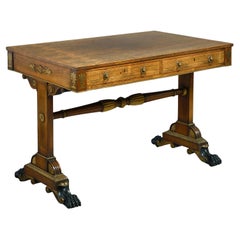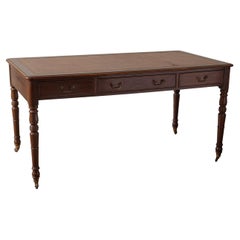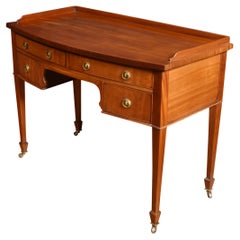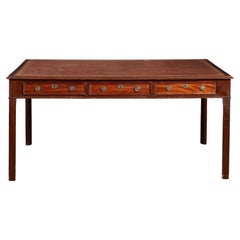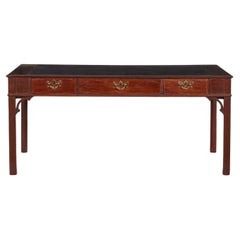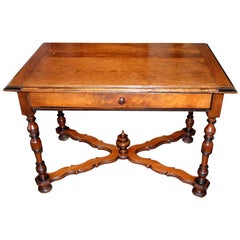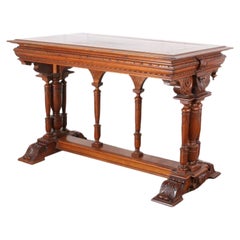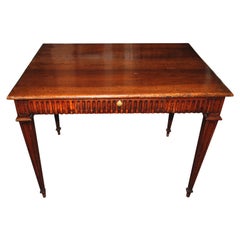Writing Table Antique
19th Century Writing Table Antique
Rosewood
Early 20th Century English Regency Writing Table Antique
Leather, Wood, Mahogany
Early 20th Century British Writing Table Antique
Wood
19th Century English Georgian Writing Table Antique
Leather, Mahogany
Late 18th Century English Writing Table Antique
Mahogany
Mid-18th Century French Writing Table Antique
Walnut
1870s French Writing Table Antique
Walnut
18th Century and Earlier French Writing Table Antique
Walnut
19th Century Swedish Writing Table Antique
Pine
1910s Austrian Vienna Secession Writing Table Antique
Beech, Bentwood
Late 18th Century French Louis XIV Writing Table Antique
Walnut
1820s Writing Table Antique
Rosewood
Late 19th Century British Writing Table Antique
Walnut
1850s British Early Victorian Writing Table Antique
Mahogany
1890s Writing Table Antique
Mahogany
1920s French Art Deco Writing Table Antique
Mahogany
1780s Italian Rococo Writing Table Antique
Leather, Poplar, Walnut
19th Century Russian Neoclassical Writing Table Antique
Brass
1880s Revival Writing Table Antique
Mahogany
Mid-18th Century Unknown Louis XV Writing Table Antique
Walnut
1820s English Regency Writing Table Antique
Rosewood
Early 20th Century English Writing Table Antique
Mahogany
19th Century French Writing Table Antique
1860s Victorian Writing Table Antique
Mahogany
Mid-19th Century Swedish Writing Table Antique
Pine, Paint
19th Century Spanish Writing Table Antique
Iron
Late 19th Century French Louis XV Writing Table Antique
Leather, Walnut
Late 19th Century English Writing Table Antique
Mahogany
Early 1900s Austrian Jugendstil Writing Table Antique
Beech, Bentwood
Early 20th Century British Writing Table Antique
Wood
Mid-19th Century English Gothic Revival Writing Table Antique
Oak
1830s English Writing Table Antique
1780s English Georgian Writing Table Antique
Mahogany
1720s Queen Anne Writing Table Antique
Leather, Oak, Walnut
19th Century French Louis Philippe Writing Table Antique
Silver, Brass
Late 19th Century British Writing Table Antique
Wood
18th Century English George II Writing Table Antique
Leather, Mahogany, Oak
Late 18th Century French Louis XVI Writing Table Antique
Bronze
Early 19th Century Russian Neoclassical Writing Table Antique
Brass
19th Century Writing Table Antique
Oak
19th Century British Regency Writing Table Antique
Oak, Leather
Mid-19th Century English Writing Table Antique
Walnut
Late 19th Century French Napoleon III Writing Table Antique
Walnut
1920s American Industrial Writing Table Antique
Oak
1770s English Georgian Writing Table Antique
Leather, Mahogany
18th Century Portuguese Baroque Writing Table Antique
Rosewood
1810s Great Britain (UK) Writing Table Antique
Mahogany
Late 19th Century Spanish Writing Table Antique
Pine
Early 20th Century Hungarian Empire Writing Table Antique
Pine
Late 19th Century French Writing Table Antique
Kingwood
19th Century Irish Writing Table Antique
Mahogany
17th Century European Writing Table Antique
Chestnut, Walnut
1910s Arts and Crafts Writing Table Antique
Pine
Late 19th Century European Writing Table Antique
Mahogany
Late 18th Century French Louis XVI Writing Table Antique
Bronze
Early 19th Century English Regency Writing Table Antique
Mahogany
1890s Writing Table Antique
Mahogany
1810s British Georgian Writing Table Antique
Mahogany
Late 18th Century Italian Louis XV Writing Table Antique
Poplar, Walnut
1890s Sheraton Writing Table Antique
Mahogany
- 1
- ...
Writing Table Antique For Sale on 1stDibs
How Much is a Writing Table Antique?
Finding the Right Desks-writing-tables for You
Choosing the perfect writing desk or writing table is a profoundly personal journey, one that people have been embarking upon for centuries.
Queen Atossa of Persia, from her writing table circa 500 B.C., is said to have been the originator of the art of handwritten letters. Hers was reportedly the first in a long and colorful history of penned correspondence that grew in popularity alongside literacy. The demand for suitable writing desks, which would serve the composer of the letters as well as ensure the comfort of the recipient naturally followed, and the design of these necessary furnishings has evolved throughout history.
Once people began to seek freedom from the outwardly ornate styles of the walnut and rosewood writing desks and drafting tables introduced in the name of Queen Victoria and King Louis XV, radical shifts occurred, such as those that materialized during the Art Nouveau period, when designers longed to produce furniture inspired by the natural world’s beauty. A prime example is the work of the famous late-19th-century Spanish architect Antoni Gaudí — his rolltop desk featured deep side drawers and was adorned with carved motifs that paid tribute to nature. Gaudí regularly combined structural precision with decorative elements, creating beautiful pieces of furniture in wood and metal.
Soon afterward, preferences for sleek, geometric, stylized forms in furniture that saw an emphasis on natural wood grains and traditional craftsmanship took hold. Today, Art Deco desks are still favored by designers who seek to infuse interiors with an air of luxury. One of the most prominent figures of the Art Deco movement was French decorator and furniture designer Émile-Jacques Ruhlmann. With his use of neoclassical motifs as well as expensive and exotic materials such as imported dark woods and inlays of precious metals for his writing desks, Ruhlmann came to symbolize good taste and modernity.
The rise in appreciation for Scandinavian modernism continues to influence the design of contemporary writing desks. It employs the “no fuss” or “less is more” approach to creating a tasteful, sophisticated space. Sweden’s master cabinetmaker Bruno Mathsson created gallery-worthy designs that are as functional as they are beautiful. Finnish architect Alvar Aalto never viewed himself as an artist, but, like Mathsson, his furniture designs reflected a fondness for organic materials and a humanistic approach. Danish designers such as Hans Wegner introduced elegant shapes and lines to mid-century desks and writing tables, often working in oak and solid teak.
From vintage desks to contemporary styles, 1stDibs offers a broad spectrum of choices for conducting all personal and business writing and reading activities.
- How do I identify an antique table?2 Answers1stDibs ExpertFebruary 22, 2021You can identify an antique table in a number of ways. The first clue that a table is antique is the joinery. If a piece of furniture is dovetailed by hand, it only has a couple of dovetails, which are uneven. Also, antique tables are not defined by perfect symmetry. Lastly, antique tables were typically made of oak, mahogany, and walnut.
 Bonnin Ashley Antiques IncFebruary 23, 2021In addition to the joinery you can check the bottoms of the drawers and the backs of the cabinets. If they were made prior to 1850 then the wood will most likely be dimensioned by hand. It will be uneven to the touch. The secondary wood that receives the veneer will have been scraped smooth but drawer bottoms, backs and bottoms are often left less finished.
Bonnin Ashley Antiques IncFebruary 23, 2021In addition to the joinery you can check the bottoms of the drawers and the backs of the cabinets. If they were made prior to 1850 then the wood will most likely be dimensioned by hand. It will be uneven to the touch. The secondary wood that receives the veneer will have been scraped smooth but drawer bottoms, backs and bottoms are often left less finished. - What is an antique rent table?2 Answers1stDibs ExpertApril 5, 2022An antique rent table is a piece of furniture that landlords and tenants used to exchange rent. The rent money would be placed in one drawer, the table would rotate for the landlord to receive. It was considered polite and gentlemanly to pay rent this way. Shop a collection of antique rent tables from some of the world’s top sellers on 1stDibs.1stDibs ExpertApril 5, 2022A rent table is a small circular or polygonal table with drawers. Rent tables frequently had drawers labeled for the days of the week, and English landlords in the 18th century often used them to collect rent. On 1stDibs, shop antique rent tables from some of the world’s top sellers.
- 1stDibs ExpertMay 5, 2023To determine whether a side table is an antique, closely examine its details. Older pieces will typically have telltale features like wood pegs, hand-cut dovetails with some slight imperfections and mortise-and-tenon construction. Tables that are a consistent color throughout or have machine-cut moldings or carvings are unlikely to be antiques. A certified appraiser or knowledgeable antiques dealer can be a helpful resource when dating tables. Shop a collection of antique, vintage and modern side tables on 1stDibs.
- 1stDibs ExpertApril 5, 2022To identify your antique dining table, first check to see if there is a maker’s mark on the underside. If there are no identifying marks or stamps, a furniture appraiser can check the style and the hardwood used to identify your piece. Shop a collection of antique furniture from some of the world’s top sellers on 1stDibs.
- 1stDibs ExpertOctober 24, 2024To tell if a kitchen table is antique, look under the table and on the legs for a maker's mark. It may be carved, branded or stamped onto the surface or appear on a paper or metal label. Using the marking, you can consult trusted online resources to learn about the maker and view catalogues of their pieces, searching for tables similar to yours. If your kitchen table was produced at least 100 years ago, it is an antique. Keep in mind that not all antique furnishings have maker's markings. In the event that you're unable to locate a mark, a certified appraiser or knowledgeable antique dealer can evaluate your piece for you. On 1stDibs, explore a diverse assortment of tables.
- 1stDibs ExpertFebruary 13, 2023While you can look for markings and other details to try and determine the maker, the best way to identify an antique drop leaf table is to work with a certified appraiser. Trusted online venues and search engines can be helpful when conducting research on a specific collectible, piece of jewelry, art work or other item about which you may have questions, but qualified professionals, such as an antiques dealer or an appraiser at an auction house, have the knowledge and experience needed to make more accurate identifications. Shop a selection of antique, vintage and modern tables on 1stDibs.
Read More
20 Inviting Dining Rooms Perfectly Arranged for Entertaining
Top interior designers show — and tell — us how to create delectable spaces for hosting dinner parties.
This Alain Delon–Designed Table Is Almost as Handsome as He Was
Fans of the French film star may be surprised to learn that he had a flair for furniture with sleek lines and disco-era flash.
Uchronia’s Plant Stand Gives Pots a Pretty Perch with All the Trimmings
Like other pieces in the firm’s Candy Box collection, the cheerful limited-edition design showcases French craft.
The Ultimate Guide to Types of Tables for the Home
Whether you’re just moving in or ready to give your home a makeover, our guide will give you pointers on tables that are fitting for every room, nook and hallway.
Is Lionel Jadot the Willy Wonka of Upcycled Belgian Design?
From his massive collaborative workshop in a former paper factory, the designer concocts funky furniture from disused materials, as well as luxe hotel interiors like the new Mix Brussels.
Inspired by the Cosmos, Sandra Nunnerley’s Nova Table Has a Futuristic Feel
The designer’s innovative use of an unexpected material gives this console a lift.
This 19th-Century Gilded Desk Displays a Fanciful Kingdom in Marquetry
The stately piece brings both gravitas and whimsy to any work space.
In Guadalajara, These Luscious Side Tables Are Chiseled from Volcanic Rock
Use them as tables or stools, indoors or out.
